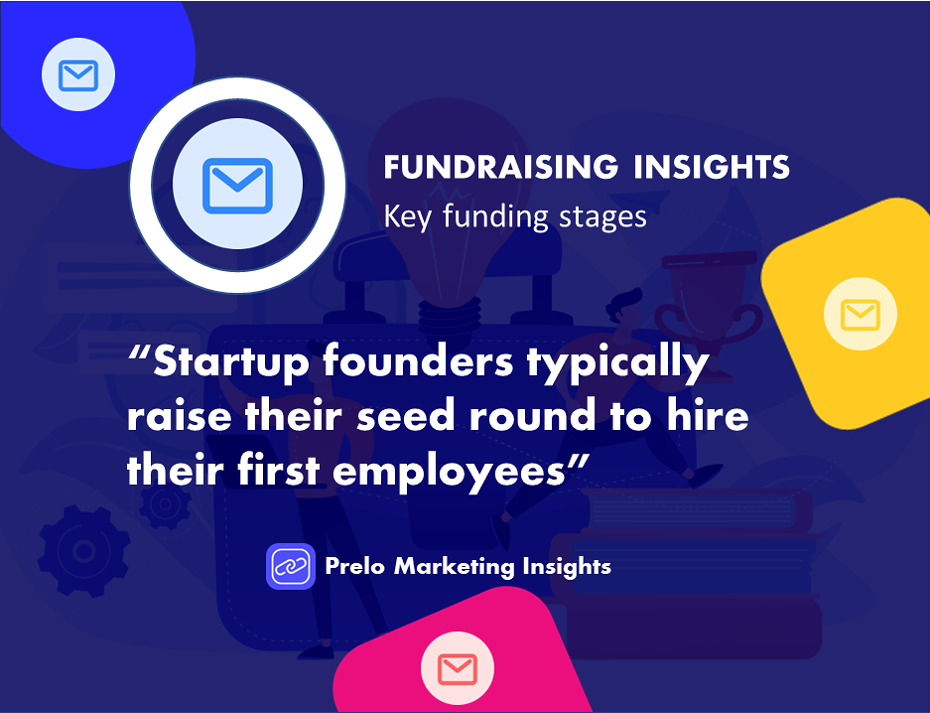I share a lot of information about Startups and funding 💰, so I figured it was time to write something that broke down startup funding stages means, how much is typically raised and what the investors tend to look for at each stage of funding.
I had a secondary reason, I want to help Prelo customers better understand our data so that their products and services can be better positioned to their ideal customers.
So many people have asked me how the funding stages work. I have a broad view having been in the Startup space for sometime. Needless to say, I decided to do a little more digging and I’ve provided a quick guide below.
Before we get into this month’s blog, I’d love to connect with you!
Soooo, let’s do it follow me on twitter (my DM’s always open) 📨

💡 What are the stages of funding a Startup ?
1️⃣ Pre-Seed
This is the first startup funding stage, Pre-seed round is outside of the other funding rounds. Close friends typically come together to fund a pre-seed round.
Some people call it the “friends and family” round. This terminology is being phased out due to the “privileged” connotations it carries.
Founders raise a pre-seed round to get their companies started, that is, to validate their Startup idea.
This could be in the form of just building a proof-of-concept tech or kicking off a marketing campaign to determine if the problem they’re trying to solve is a real problem
Founders looking for pre-seed funding are typically raising anything from $5,000 – $50,000
2️⃣ Startup Funding Stage – Seed
Founders look for seed funding to provide the necessary financial injection to their Startup, especially if it’s on the cusp of generating revenue.
The funds raised in this Startup’s funding stage is used to hire it’s first employees and consequently pay for tech infrastructure, sales and marketing costs.
Seed funding is regarded as the official first stage of funding for a Startup. This is when a Startup first receives external funding to help support their vision.
At this seed stage a founder must look for investors and convince them either through conversation or a formal “demo day” that the Startup idea has been validated.
At the seed stage, founders typically look for angel investors or High Net Worth Individuals (HNWI) to invest in their venture.
There’s a movement at present to democratize investing so companies providing equity crowdfunding services are also a good source for founders to find initial seed investment.
Founders looking for seed funding are typically raising anything from $50,000 – $3,000,000
3️⃣ Startup Funding Stage – Series A
Series A funding rounds provide investment to help a Startup scale the execution of its go-to-market strategy, essentially it allows founders to demonstrate their ability to scale a company.
Similar to the seed funding stage, this is a funding round that allows investors to provide capital in return for equity in a Startup. This is known as equity-based funding. When Startups approach their Series A funding round, there are some key indicators that investors typically look for here.
- Traction, without traction it’s extremely difficult to convince investors at this stage
- Product Market Fit (PMF) demonstrable, repeatable process for finding customers
- Demonstrate that you know how to scale
- Share your big vision, how are you changing an industry/the world
- Ability to hire and build teams (management, operational and technical)
Founders looking for Series A funding are typically raising anything from $3,000,000 – $6,000,000
4️⃣ Startup Funding Stage – Series B
Startups raise Series B funding rounds to facilitate expansion. Startups with a proven business model and demonstrable product-market fit tend to raise a series B investment round in order to expand their operations geographically and/or through new products.
At this stage of funding, investors are interested in the attrition rate of the Startup. How well has the founder retained top talent in the company. Have those individuals whom you hired at Series A still there.
Are they bought into your vision, how much of your time is spent fighting fires? Have you delegated some operational and strategic duties to your management team? How successful have you been at executing your go-to-market (GTM) strategy
Founders looking for Series B funding are typically raising anything from $10,000,000 – $30,000,000
5️⃣ Startup Funding Stage – Series C
Series C funding attracts private equity, late-stage venture capitalists and hedge funds. This stage is for the investors to join the cap-table and inject the funds to eventually enable the Startup to grow and scale quickly. Average Series C funding round is around $50MM in funding.
For founders, giving these “heavy-weight” investors the confidence that you and your team are the right people to take the company to the next stage is vital.
If you are a founder looking for a Series C funding, you would typically be raising anything from $30,000,000 – $50,000,000
6️⃣ Startup Funding Stage – Series D
From a VC’s perspective, this is the 4th stage of a Startup’s funding journey. Startups can either grow organically or via a merger or an acquisition.
Historically, Series D funding is used to fund strategic growth such as an acquisition. We’ll continue to add more funding rounds to this article over the coming months.
Founders looking for Series D funding are typically raising anything above $50,000,000
7️⃣ Debt Funding (Debt Financing)
This one does not involve the transfer of equity. Debt financing as you would’ve seen in our list of funding stages is when a Startup raises funds for net working capital or capital expenditure by selling something like a bond (debt instrument)
Debt Funding promises creditors a pay back of both the principal (amount borrowed) and the interest. Imagine taking out a mortgage because you’ve promise to pay back the loan and the interest over a specified timeframe.
The more common way for Startups to raise funding as I’ve described with the 6 funding stages is via equity financing.
8️⃣ Convertible Note
A convertible note is a short-term loan that converts to equity. For example, if you think about a bond that converts into equity.
When an investor loans money to a Startup, instead of receiving a repayment plan, which as we described in Debt Funding or Debt Financing to be Principal + Interest, the Investor receives equity in the company to the tune of the value of the loan, the interest and any additional terms tied into the contract.
On twitter : 🐤 @oluadedj
subscribe : 📰 prelo newsletter
Until the next time!
Olu
Founder, Prelo
I tweet about helping founders win!



